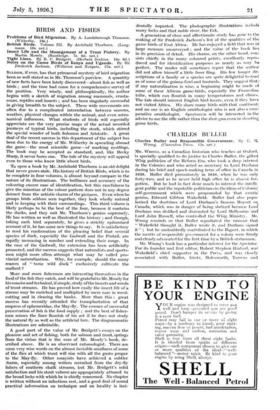BIRDS AND FISHES
Problems of Bird Migration. By A. Landsborough Thomson. (Witherby. 188.)
British Birds. Volume III. By Archibald Thorburn. (Long. mans. 16s. net.)
Insect Life and the Management of a Trout Fishery. By Martin Mosely. (Routledge. is. 6d. net.) SELDOM, if ever, has that primaeval mystery of bird migration been so well stated as in Mr. Thomson's purview. A quantity of new facts have been lately discovered—about fish as well as birds ; and the time had come for a comprehensive survey of the position. Very wisely, and philosophically, the author begins with a sketch of migration among mammals, crusta- ceans, reptiles and insects ; and has been singularly successful in giving breadth to the subject. These wide movements are often due to a complicated interrelation between seasons, weather, physical changes within the animal, and even astro- nomical influences. What students of birds will especially appreciate are the very precise maps of the actual recorded journeys of typical birds, including the stork, which stirred the special wonder of both Solomon and Aristotle. A great deal of the recent success in this department of the subject has been due to the energy of Mr. Witherby in spreading abroad the game—the most scientific game—of marking nestlings. The book may be accepted as standard, and, like Becky Sharp, it never bores one. The tale of the mystery will appeal even to those who know little about birds.
To open a book by Mr. Archibald Thorburn is an old delight that never grows stale. His history of British Birds, which is to be complete in four volumes, is almost beyond compare in the nature of its illustrations. The brilliance and accuracy of the colouring ensure ease of identification, but this carefulness to give the minutiae of the colour pattern does not in any degree detract from the artistic charm of the pictures. Even when he groups birds seldom seen together, they look wholly natural and in keeping with their surroundings. This third volume is likely perhaps to be the best of the four, because it contains the ducks, and they suit Mr. Thorburn's genius supremely. He has written as well as illustrated the history ; and though, taking each bird separately, he gives a strictly epitomized account of it, he has some new things to say. It is satisfactory to read his confirmation of the pleasing belief that several species of duck, especially the Gadwall and the Pintail, are rapidly increasing in number and extending their range. In the case of the Gadwall, the extension has been artificially promoted, and the success suggests that naturalists and sports- men might more often attempt what may be called pro- vincial naturalization. Why, for example, should the many rearers of "tame wild duck" exclusively cultivate the mallard ?
More and More fishermen are interesting themselves in the food of the fish they catch, and will be grateful to Mr. Mosely for his concise and technical, if simple, study of the insects and weeds of trout streams. He has proved how easily the insect life of a stream may be enriched and multiplied by mere care in weed- cutting and in clearing the banks. More than this : great success has recently attended the transplantation of that empress of ephemeridae, the May-fly-. The essence of successful preservation of fish is the food supply ; and the best of fisher- men misses the finer flourish of his art if he does not study the natural fly as well as the artificial lure. The diagrammatic illustrations are admirable.
" A good part of the value of Mr. Bridgett's essays on the pleasure and art of fishing, both for salmon and trout, springs from the virtue that is the core of Mr.. Mosely's book, de- scribed above. He is an observant entomologist. There are some very wise words on the almost invisible smallness of some Of the flies at which trout will rise with all the gusto proper to the May-fly. Other essayists have achieved a subtler harm, especially among writers recruited from the dry-fly fishers of southern chalk streams, but Mr. Bridgett's solid satisfaction and his stout volume are appropriately attuned to the broad lochs with which he is chiefly concerned. No chapter is written Without an infectious zest, and a good deal of sound
practical information on technique and on locality is inci- . . . dentally imparted. The photographic illustrations it:chichi many lochs and that noble river, the Esk.
A generation of close and affectionate study has gone to the making of Sir Frederick Jackson's list of the qualities of the game birds of East Africa. He has enjoyed a field that was id large measure unsurveyed ; and the value of the book lies in its precision of detail. His charm, on the other hand, con; sists chiefly in the many coloured prints, excellently repro- duced and for identification purposes as nearly as may ba perfect. The reader will sometimes regret that the author did not allow himself a little freer fling. His few longer de4 scriptions of a family or a species are quite delightful to read as of some of the guinea-fowl and bustards. They suggest that; if any naturalization is wise, a beginning might be made of some of these African game-birds, especially the Francoline tribe, which can flourish in many temperatures and climes. The tale should interest English bird lovers, even if they have not visited Africa. We share many birds with that continent/ and no one is an English ornithologist who is not also a com: parative ornithologist. Sportsmen will be interested in the: advice to use the rifle rather than the shot-gun even in shooting game birds.










































 Previous page
Previous page